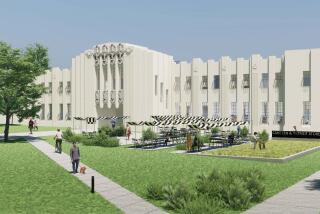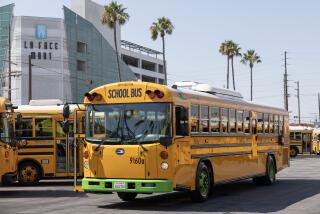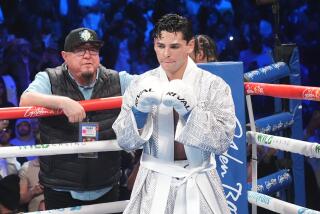L.A. Unified Plans to Save Part of Ambassador Hotel
After years of debate over the fate of the Ambassador Hotel, Los Angeles schools Supt. Roy Romer has selected a plan to save some historically significant elements of the hotel but demolish most of it in favor of a new kindergarten-through-12th-grade school on the 23-acre site.
The $318.2-million plan is intended as a compromise by Romer to appease increasingly vocal opponents of razing the hotel and find an expedient way to build a much-needed school in a neighborhood from which 3,800 students are bused elsewhere each day.
For the record:
12:00 a.m. Sept. 18, 2004 For The Record
Los Angeles Times Saturday September 18, 2004 Home Edition Main News Part A Page 2 National Desk 1 inches; 52 words Type of Material: Correction
‘A Star Is Born’ actress -- A graphic in Sunday’s Section A with an article about L.A. Unified School District’s plans to save part of the Ambassador Hotel said the 1937 movie “A Star is Born” starred Judy Garland. Janet Gaynor was in the leading role. Garland starred in a 1954 version.
The 4,200-student school would be one of 160 that the Los Angeles Unified School District hopes to build in the next eight years to relieve overcrowding and move students off year-round schedules.
“This is a good compromise,” Romer said Saturday. “It incorporates the values that we feel are essential and tries to preserve historic aspects, but it enables us to make a workable school community.”
From Wilshire Boulevard, officials said, the view of the old hotel would be almost unchanged because of a facade that would duplicate the look of the original six-story hotel.
Portions of the Embassy Ballroom, where presidential candidate Robert F. Kennedy gave his last speech in 1968 before he was mortally wounded in a hotel kitchen pantry nearby, would be saved and reinstalled in a library elsewhere on the property.
The Cocoanut Grove nightclub, where movie stars mingled and Hollywood’s brightest stars performed, would be restored to its original Moorish design, abandoned years ago. It would become the school’s main auditorium.
Most of the arcade of shops directly beneath it would be kept; the Paul Williams-designed coffee shop, among the more significant architectural elements of the property, would be preserved as a teachers lounge, and other shops would serve as the entrance to a middle and upper school cafeteria.
Among the elements of the hotel to be demolished under the new plan are six large bungalows where such celebrities as F. Scott Fitzgerald, Rudolph Valentino and Albert Einstein once stayed, as well as the hotel’s ornate, red-carpeted lobby.
The Board of Education will vote on the proposal in the next month or so. If its members approve and there are no legal impediments, officials said, the kindergarten-through-third-grade portion of the school could open as early as 2008, and the rest a year later.
The Ambassador plan, said Jose Huizar, president of the school board, “is the best solution for Los Angeles and its children. We have attempted to balance our desire for new facilities with our desire to honor the heritage of the site. The elements we are preserving are the elements most people would remember about the hotel: the Cocoanut Grove, the Embassy Ballroom and the iconic view from Wilshire Boulevard.”
But the plan, which will be formally unveiled this week, is already generating criticism.
Ken Bernstein, director of preservation issues for the Los Angeles Conservancy, which has pushed the district to save most of the hotel, called the plan “an amputation of the Ambassador.”
He likened it to Disney’s artificial re-creations of history at its theme parks. “We all love Disneyland,” Bernstein said, “but we’d rather not learn how to read and write there.”
Bernstein said the conservancy already has made significant concessions by supporting a district option that included significant demolition. On Friday, the conservancy suggested how the district might use federal tax credits to pay for more renovation than the latest plan calls for.
Before deciding whether to take legal action against the plan, Bernstein said the conservancy wants to review the final environmental impact report.
When the hotel opened on Jan. 1, 1921, it was one of several that “expressed and fulfilled the aspirations of an emergent city,” said historian Kevin Starr.
Its construction by architect Myron Hunt on a former dairy farm helped to push the expansion of Los Angeles west.
In its heyday, the hotel was seen as a playground for the rich, powerful and famous. Joan Crawford and Bing Crosby were discovered there. Several early Academy Awards ceremonies were held at the Ambassador.
“Everyone knew it, and everyone wanted to come to it,” said Margaret Burk, author of a book about the hotel.
Since the Ambassador closed its doors in 1989, it has been the focus of a number of plans, including Donald Trump’s vision of a 125-story office and residential structure and the school board’s persistent fight to gain control of the site. The conservancy has kept a watchful eye on all the suggestions, wanting to retain as much of the original building as possible.
After the school district managed to buy the property in U.S. Bankruptcy Court in 2001, the focus shifted to how to convert the hotel to a school and how much of it to preserve.
Both the conservancy and the RFK-12 Coalition, an umbrella group of organizations and individuals formed a year ago to support total demolition of the hotel for construction of a new school, have offered their own plans for the property. The boards of both groups are scheduled to meet Monday to discuss the latest proposal.
Representatives from RFK-12 would not comment on the district’s plans Saturday, but said that at this point, the group still favors razing all of the original structure.
But school officials insist that their plan is best.
“We believe that what we have done is really the best chance to create a workable education facility,” Romer said, while “at the same time, honoring the history of the site.”
The school, said Richard Alonzo, Los Angeles Unified’s local superintendent for the area that includes the Ambassador Hotel, would represent “a seamless approach to learning.”
Alonzo said the school would be composed of three distinct areas, a kindergarten-through-third-grade lower school, fourth-through-eighth-grade middle school and ninth-through-12th-grade upper school.
There would be about 200 students per grade level until ninth grade, when there would be 600 students in each grade. The high school would be split into smaller academies, Alonzo said, each with specific thematic or instructional focuses.
The property would include almost 17 acres of green space, including two soccer fields and a community park along Wilshire Boulevard.
Officials said that they hope the park would contain a memorial to Kennedy as well as a sloped green area that could be used for graduation ceremonies, outdoor concerts or other events.
In a letter addressed to parents and students earlier this year, one of Kennedy’s children, Kathleen Kennedy Townsend, called a “brand new, state-of-the-art K-12 learning center” on the Ambassador site “a deeply appropriate memorial” to her father’s legacy.
School officials have not decided what to do with the kitchen pantry where Kennedy was shot by Sirhan Sirhan. Huizar said there was concern that debate over whether to preserve the pantry would “fog up the issues involved in putting a school” on the site.
Officials plan to appoint a blue-ribbon panel of outside experts to decide what to do with the pantry, a small room with primitive circuit boxes, an old-fashioned ice machine and peeling paint. If it is kept, it would be moved from its current location at a cost of about $2 million.
The draft environmental impact report for the school, issued in June 2003, estimated that razing the hotel and its outbuildings entirely and replacing them with new buildings would cost $286 million.
Since then, in part because of rising costs of construction materials, officials have revised that estimate to $310 million. The option that would include the maximum reuse of the original building, earlier expected to cost $382 million, is now estimated at $419 million.
The project would be paid for with money raised through a construction bond that already has been approved by voters. But the district has expressed trepidation about using any of the $14 billion raised through several school-construction bonds for historic preservation.
John Perez, president of United Teachers Los Angeles, said his organization has always maintained that the district should not allocate any of that bond money toward restoration of the site. Union officials will meet this week to decide whether the new plan meets their criteria, he said.
The teachers union supports the district’s efforts to build schools as fast and efficiently as possible, Perez said.
“We want that school up and open,” he said. “Because that community is busing out thousands of students a day. The citizens and parents in that community deserve to have that property developed and that school opened.”
*
(BEGIN TEXT OF INFOBOX)
Chronology of the Ambassador Hotel
The Ambassador Hotel, closed for 25 years, is best remembered as the place where Robert F. Kennedy was shot in 1968.
New Year’s Day 1921 -- The Ambassador Hotel opens to great fanfare.
April 3, 1930 -- The second annual Academy Awards is broadcast on radio from the Cocoanut Grove.
1937 -- “A Star Is Born,” starring Judy Garland, is among the first of many movies to be filmed on the property.
June 5, 1968 -- Just after midnight, Sen. Robert F. Kennedy is shot after a presidential primary victory speech in the ballroom.
1970-71 -- Jurors who convict Charles Manson are sequestered at the hotel for 8 1/2 months.
Jan. 3, 1989 -- Declining business along once-thriving Wilshire Boulevard forces the majestic old hotel to shut its doors.
July 1989 -- The hotel is sold for $64 million to an investment group headed by a New York developer. Manhattan developer Donald Trump acquires an interest in the group and becomes managing partner.
July 17, 1989 -- Within days of the sale, the Los Angeles Unified School District Board of Education approves a plan to buy the property and build a 2,000-student high school.
Jan. 13, 1990 -- Trump announces plans to demolish the hotel to build the nation’s tallest building -- 125 stories -- on the site.
June 18, 1990 -- The school board votes to begin the process to take over the hotel. A month later, the board agrees to deposit $50 million in an escrow account for the land.
Sept. 20, 1993 -- The school district drops its bid to purchase the hotel in favor of a new site near downtown that would become the Belmont Learning Center.
Dec. 4, 1997 -- A judge rules that the school district can recover the $50 million it paid developers in its abortive attempt to buy the property. The district later begins foreclosure proceedings to recover the money.
Nov. 28, 2001 -- After the development group files for bankruptcy protection, a judge approves the sale of the hotel to the school district.
Dec. 13, 2001 -- The school district completes its purchase of the hotel, ending a decade-long legal struggle over the property, and opening the way for a school to be built on the 23-acre site.
Sept. 11, 2004 -- The school district announces plans to raze most of the hotel and incorporate parts of it in a school.
Source: Los Angeles Times
Los Angeles Times
More to Read
Sign up for Essential California
The most important California stories and recommendations in your inbox every morning.
You may occasionally receive promotional content from the Los Angeles Times.










